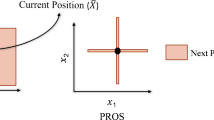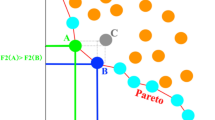Abstract
The Capacitated Minimum Spanning Tree Problem is NP-hard and several heuristic solution methods have been proposed. They can be classified as classical ones and metaheuristics. Recent developments have shown that metaheuristics outperform classical heuristics. However, they require long computation times and there are difficulties in their parameter calibration and coding phases. This explains the popularity of the Esau–Williams (EW) heuristic in practice, and its use in many successful metaheuristics and second-order greedy methods. In this work, we are concerned with the EW heuristic and we propose simple new enhancements. Based on our computational experiments, we can say that they considerably improve its accuracy with minor increase in computation time, and without harming its simplicity.



Similar content being viewed by others
References
Ahuja RK, Orlin JB and Sharma D (2001). Multi-exchange neighborhood structures for the capacitated minimum spanning tree problem. Math Prog Ser A 91: 71–97.
Ahuja RK, Orlin JB and Sharma D (2003). A composite very large-scale neighborhood structure for the capacitated minimum spanning tree problem. Opns Res Lett 31: 185–194.
Altınel İK and Öncan T (2005). A new enhancement of the Clarke and Wright savings heuristic for the capacitated vehicle routing problem. J Opl Res Soc 56: 954–961.
Amberg A, Domschke W and Voss S (1996). Capacitated minimum spanning trees: Algorithms using intelligent search. Combin Optim: Theory Pract 1: 9–39.
Beasley JE (2005). ORLIB: Operations Research Library, http://people.brunel.ac.uk/~mastjjb/jeb/info.html, last accessed October 2007.
Bruno G and Laporte G (2002). A simple enhancement of the Esau–Williams heuristic for the capacitated minimum spanning tree problem. J Opl Res Soc 53: 583–586.
Camerini PM, Galbiati G and Maffioli F (1980). Complexity of spanning tree problems: Part I. Eur J Opl Res 5: 346–352.
Camerini PM, Galbiati G and Maffioli F (1983). On the complexity of finding multi-constrained spanning trees. Disc Appl Math 5: 39–50.
Clarke G and Wright JW (1964). Scheduling of vehicles from a central depot to a number of depots. Opns Res 12: 568–581.
Dai HK and Fujino S (2000). On designing constrained local access networks. In: Sudborough IH and Hsu DF (eds). Proceedings of the 2000 International Symposium on Parallel Architectures, Algorithms, and Networks (ISPAN'00). IEEE Computer Society Press: Los Alamitos, CA, USA, pp. 167–176.
Esau LR and Williams KC (1966). On teleprocessing system design. Part II—A method for approximating the optimal network. IBM Syst J 5: 142–147.
Gaskell T (1967). Bases for vehicle fleet scheduling. Opl Res Quart 18: 281–295.
Gavish B (1991). Topological design of telecommunication networks—Local access design methods. Ann Ops Res 33: 17–71.
Hall L (1996). Experience with a cutting plane algorithm for the capacitated spanning tree problem. INFORMS J Comput 8: 219–234.
Jothi R and Raghavachari B (2003). Design of local access networks. In: Gonzalez T (ed). Proceedings of the 15th IASTED International. Conference on Parallel and Distributed Computing Systems (PDCS). Acta Press: Marina del Rey, CA, USA, pp. 883–888.
Karnaugh M (1976). A new class of algorithms for multipoint network optimization. IEEE Trans Commun 24: 500–505.
Kershenbaum A, Boorstyn R and Oppenheim R (1980). Second-order greedy algorithms for centralized teleprocessing network design. IEEE Trans Commun 28: 1835–1838.
Martello S and Toth P (1990). Knapsack Problems: Algorithms and Computer Implementations. John Wiley and Sons: New York.
Paessens H (1988). The savings algorithm for the vehicle routing problem. Eur J Opl Res 34: 336–344.
Papadimitriou CH (1978). The complexity of the capacitated tree problem. Networks 8: 217–230.
Patterson R and Pirkul H (2000). Heuristic procedure neural networks for the CMST problem. Comput Opns Res 27: 1171–1200.
Patterson R, Pirkul H and Rolland E (1999). A memory adaptive reasoning technique for solving the capacitated minimum spanning tree problem. J Heuristics 5: 159–180.
Sharaiha YM, Gendreau M, Laporte G and Osman IH (1997). A tabu search algorithm for the capacitated shortest spanning tree problem. Networks 29: 161–171.
Yellow P (1970). A computational modification to the savings method of vehicle scheduling. Opl Res Quart 21: 281–283.
Acknowledgements
This research has been partially supported by Boǧaziçi Research Fund Grant No: 04HA301D.
Author information
Authors and Affiliations
Corresponding author
Rights and permissions
About this article
Cite this article
Öncan, T., Altınel, İ. Parametric enhancements of the Esau–Williams heuristic for the capacitated minimum spanning tree problem. J Oper Res Soc 60, 259–267 (2009). https://doi.org/10.1057/palgrave.jors.2602548
Received:
Accepted:
Published:
Issue Date:
DOI: https://doi.org/10.1057/palgrave.jors.2602548




